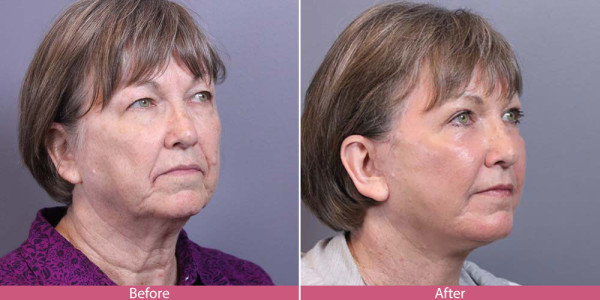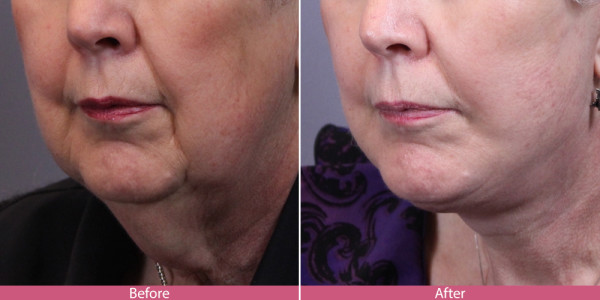You
Only Younger™
Real Patient Photos*
A Few Reasons to Choose Facial Beauty
Low Risk Procedures
Every procedure requires some for of anesthesia and traditionally this is a General Anesthesia, meaning you are completely knocked out. At Facial Beauty, we utilize cutting-edge local anesthesia procedures where you are not fully knocked out but completely comfortable. The advantage of Local Anesthesia that there are less complications & faster recovery time. Our procedures generally take from an hour and thirty minutes to no more than three hours, allowing us to dramatically reduce any risk involved in the procedure.


Limited Downtime
The biggest drawback to major facial surgery is the downtime. While recovery time can vary case by case, generally patients can return to work between seven to ten days after the procedure. We do everything we can for our patients to get you back to your family and back to your daily life of activity & exercise as soon as possible.
Simple & Affordable Financing
At Facial Beauty, we offer low monthly payment plans and pre-qualifications for any additional treatments, affordability has never been easier. If you’ve ever let financing stand in your way of a new you, come talk to us about options you may not know you had. We can even do pre-approvals over the phone so please feel free to contact us anytime.

Frequently Asked Questions
What does the procedure involve?
- Limited incision.
- Local anesthesia.
- “Tailored” (according to individual’s needs) natural lift, or minilift.
- Specialized and Expert Facial Rejuvenation Surgeon.
What type of anesthesia do you use?
- Commonly performed under local tumescent anesthesia with mild sedation
- IV sedation or general anesthesia with tumescent anesthesia assistance in selected instances.
What is a typical recovery time?
- Refrain from work or exertional activity for the first seven days.
- Makeup can be applied after seven days as needed.
- Return to work based on the case-by-case basis, generally between seven to ten days postoperative.
- Resume normal exertional activity, aerobics, and jogging, after two weeks.
What is the recovery like?
- Limited need (1 to 3 days) for pain medication.
- Functional at home the day after the procedure.
- Bruising and swelling last seven to ten days.
- Full exertional activity (aerobics, jogging) after two weeks.
- Socially acceptable generally by 10 days with makeup.
- Makeup can be applied after seven days to hide the facial bruising.
- Long hair can hide the lumps, bumps, and incisions around the ear.
What can I do to help my recovery?
- Cold and ice compresses to the facial and neck areas in and around the wrap for up to 48 hours.
- No exertional activity. No lifting, jogging, or running for two weeks.
- Head of bed elevation during the day or during sleep at 30-degree angle for up to two weeks.
- Take prescribed medications according to the directions provided.
- Head wrap provides reduction in swelling.
- Take care to follow up at one-day postoperative and seven days postoperative.
What factors have worsened the aging facial changes?
- Significant weight gain and/or weight loss.
- Advancing age.
- Familial genetic predisposition of moderate sagging jowls or sagging neck.
- Congenital fatty predisposition to the face and neck.
- Hormonal factors and hormonal dysfunction
- Poorly controlled medical conditions (i.e. diabetes, cardiac disease)
- Extensive stress (i.e. divorce)
- Moderate past sun exposure.
- Long time smoking history.
Are there any procedures typically performed along with a facelift?
- Blepharoplasty, very common.
- Fat grafting or fat injection.
- Full face laser resurfacing with fractionated CO2 laser.
- Brow lift.
What are typical motivations for a Facelift?
- Displeasure with one’s appearance in the mirror.
- Tired and weathered appearance.
- Prominent jowls.
- Saggy or full neck.
- Overall fatigued and tired look.
- Saggy wrinkled facial skin.
- An appearance similar to your parents or grandparents.
- Square lower face appearance.
- Family, friends, significant other pay less attention to you.
- Healthy, energetic and fit physical appearance does not match facial aged appearance.
Who are good candidates?
- Individuals motivated to look their best.
- Individuals dissatisfied with their facial appearance and appearance of looking older than they feel.
- Healthy individuals.
- Individuals motivated to feel their best about themselves.
- Individuals frustrated by the changes that have occurred, particularly past the age of 50 to the lower face, neck area, and jowls, and with noted neck laxity and sagging.
How old are most patients?
- Most commonly 50 to 65.
- Ages 30 to 90 have benefited.
How experienced are the surgeons?
- Board-certified Facial Plastic and Reconstructive Surgeon
- Double board-certified (Otolaryngology-Head and Neck Surgery)
- Expert facelift surgeon who performs over 300 facelifts a year.
What features of my appearance can be helped by a facelift?
- Overall descent of cheeks (malar) fat pad.
- Descent of facial structures soft tissue throughout.
- Loss of facial fat.
- Loss of skin elasticity and integrity with associated sagging.
- Advancing facial skin laxity and sagging.
- Sun damaged skin.
- Sun damaged causing skin thinning with wrinkling.
- Fatty deposition to the submentum (under the chin) area causing significant submentum fullness.
- Fatty deposition to the jowls.
- Sagging of jowls.
- Relaxation and sagging of platysmal muscle with platysmal band formation due to relaxation, and loss of tone.
- Formation of prominent nasolabial folds (laugh lines) due to sagging of skin and sagging of fat of the cheeks.
- Increased facial wrinkling from aging changes.
- Neck rolls, saggy neck.
- Aged appearing profile.
- Loss of jaw definition.
Are there any reasons why I should not get a facelift?
- Mild to moderate cardiac or pulmonary disease.
- Other significant medical illness.
- Previous radiation for cancer to the head and neck area.
- Chronic anticoagulation.
A message about facelifts from Dr. Santos:
All of us essentially undergo the inevitable changes associated with aging and aging of the face. Slowly, but surely, the face will age and change over time, and generally not for the better. Some individuals will age more quickly than others, some will age more gracefully than others, but an overall consequence of father time is ongoing anatomical changes to the face, which result in a less youthful, more wearied appearance. Probably the most important hallmarks of aging and loss of youth, center around the lower third of the face and the neck region including the changes of face and neck sagging, wrinkling, increased loose skin, fat deposition, fullness, weathering of skin, and jowl formation. In time, these changes can occur to all of us. There are many factors that accelerate this process including sun exposure, high stress, poor nutrition, weight gain, weight loss, and poor physiologic health. Further and importantly, cigarette smoking is a significant factor; the result of which is acceleration of the aging process including accelerated skin wrinkling, and skin weathering.
None of us are immune to this process and the inevitable happens particularly to men and women over 50. Those who feel youthful, energetic, and as capable as they were in their 30s and 40s, tend to become even more distraught when they realize that their facial aging changes are more advanced than their level of physical health and overall inner perception of how they perceive themselves. What happens is that instead of routinely glancing in the mirror to see how we look, we avoid the mirror altogether. We avoid the mirror at routinely because the face staring back is sad, tired, and not the person we used to be, nor the person we perceive ourselves to be. What happens is that we find that less and less the more youthful generation pays less attention to us and to what we have to say and so that we become less important in daily conversations, work, and socially. Further and of more impact to our lives, there tends to be less interest from the opposite gender. There tends to be less intimacy than there was in our 30s and 40s. The truth is facial aging impacts our life. Essentially, we do not like how others, particularly the opposite sex, look at us, and internally we understand that there is a bit of a loss of who we are and a loss of our youth. Many will argue that we do not essentially feel that we matter as much as we did in the past.
What can we do about this? Is it possible to really change the way we look, and do so of course in a natural way? Should we remain accepting of the way that we look? Should we simply say that aging gracefully is a required duty for us humans to endure? Do we essentially accept the fact that we look older than we feel going forward, particularly after the age of 50? Of all of the things we can do for ourselves, of all the procedures that we can consider, of all the facial plastic surgery options available, facial rejuvenation, particularly a natural and tailored facelift, has probably become the most desirable and the most life-transforming. This makes sense because we can always hide aging changes throughout the rest of our body including sunglasses for our eyes or heavy sweaters and baggy pants for our upper and lower torsos. A significant majority of individuals who are enthusiastic and motivated enough to make a difference in their life and who undergo a natural and tailored facelift, will experience significant satisfaction. The result is not only a better and more useful facial appearance, but so often the result is an increase in self-confidence, a sense of return of energy and vigor, a return of a sense of feeling and being significant and mattering in life’s daily events, and a sense of getting back into the saddle again. Out of experience, it is easy to say that the result is that you matter more and the opposite sex pays attention more.
When working with a board certified and highly experienced facelift surgeon a natural and more youthful (you only younger) appearance is at hand! A tailored and natural Facelift procedure is a solution that aspires to remove the hallmarks of aging; the sagging jowl; the loose redundant skin in the neck, the excess skin and tissue in the submental area. The jowls are reduced or removed, the neck becomes tighter, and the fullness of the neck goes away substantially. Often, one can lose 8 to 15 years of facial physiological age and your appearance suggests loss of weight. The result is that you look and ultimately feel younger.
If you are at all curious about what a facelift may be able to do for you or someone you care about, please feel free to reach out and I would be happy to sit down and discuss any questions you may have and what they mean for you.
Sincerely,
Dr. David Santos

David Santos MD, FACS
Dr David Santos was the Medical Director for Lifestyle Lift, responsible for hundreds of facelift surgeons and thousands of procedures. Having performed over 4,000 facelift procedures himself, Dr. Santos is committed to finding cutting edge techniques to reduce the risk and minimize the downtime of facelift procedures.
- Member American Board of Facial Plastic and Reconstructive Surgery
- Member American Board of Otolarnyngology – Head and Neck Surgery
- Member American Academy of Facial Plastic and Reconstructive Surgery





















